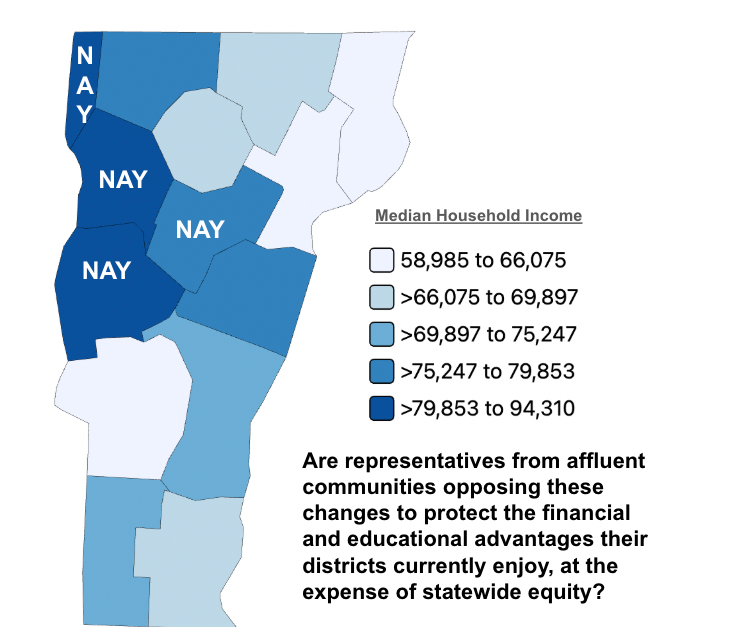Are Vermont’s Wealthier Districts Blocking Education Reform to Preserve Their Advantage?
While Vermont media outlets have extensively covered the legislative process and fiscal impacts, a critical question remains underreported.
Vermont’s education funding system, long a battleground for debates over equity and local control, is once again at a crossroads with the passage of H.454, a bill aimed at transitioning to a foundation formula. This reform, designed to standardize per-pupil funding and address inequities, has sparked fierce opposition, particularly from legislators representing wealthier districts.
While Vermont media outlets have extensively covered the legislative process and fiscal impacts, a critical question remains underreported: Are representatives from affluent communities opposing these changes to protect the financial and educational advantages their districts currently enjoy, at the expense of statewide equity?
The Foundation Formula and Its Stakes
H.454, passed by the Vermont House on April 11, 2025, with an 87-55 vote, and the Vermont Senate on May 23, 2025, proposes a seismic shift in education funding. It introduces a foundation formula that allocates a base per-pupil amount (e.g., $15,033 in the House version, compared to Governor Phil Scott’s $13,200), adjusted for factors like low-income students, English language learners, and rurality. The bill now goes to the House for a conference committee to reconcile differences.
The formula aims to reduce disparities by redistributing funds from wealthier districts, such as those in Chittenden, Addison, Washington, and Grand Isle counties, to poorer, rural areas like the Northeast Kingdom and Orange County.
This redistribution has fueled opposition, particularly from legislators whose districts face reduced funding or higher tax rates. The bill also includes school district consolidation and class-size minimums, raising fears of school closures in both rural and affluent areas. While the House version emphasizes governance changes, the Senate’s modifications, which prioritize spending controls, have drawn criticism for potentially undermining equity goals.
Wealthier Districts and the Equity Question
Wealthier districts, such as those in Chittenden County (home to Shelburne, Vermont’s richest city with an average household income of $161,333), stand to lose the most under H.454. A 2024 VTDigger report on Act 127 showed that counties like Chittenden and Addison lost weighted pupil share, while poorer regions like the Northeast Kingdom gained. This pattern aligns with historical trends: a 2021 Vermont Public report quoted Orange County Sen. Mark MacDonald saying wealthier districts “are not going to want to give up the funds that they have to spend on their school districts, which are desirable and people want to go to and get high test scores.” This suggests a deliberate effort to preserve advantages, such as higher per-pupil spending (up to $25,738 in some districts) and better facilities, which poorer districts lack.
The foundation formula challenges this status quo by prioritizing equity, as mandated by the 1997 Brigham v. State of Vermont decision, which declared unequal funding unconstitutional. Yet, opposition from wealthier districts’ representatives appears to prioritize local interests over statewide fairness. For instance, Vermont Public reported in 2024 that a 5% tax cap under Act 127 encouraged affluent districts to front-load spending, knowing future tax rates would rise to fund poorer districts. This behavior indicates a strategic effort to maximize local benefits before reforms take hold.
Media Coverage: Missing the Equity Angle?
While Vermont’s media has thoroughly covered H.454’s fiscal and governance implications, the narrative that wealthier districts’ representatives are opposing reform to protect their advantage is under-explored.
Few, if any, news outlets have directly called out the equity issue. Instead, coverage emphasizes procedural hurdles, tax concerns, and rural school closures. While these are valid angles, the lack of focus on wealthier districts’ potential self-interest overlooks a critical driver of opposition, especially given historical context from Act 60 and Act 127, where affluent areas resisted funding equalization.
Voices from the Ground
Stakeholder reactions further illuminate the equity debate. The Vermont-NEA and organizations representing superintendents, principals, and school boards supported the House’s version of H.454, which prioritizes structural reform. However, Burlington superintendent Tom Flanagan criticized the Senate’s spending-focused version, arguing it would harm districts with large English learner populations, suggesting that wealthier districts’ influence may skew reforms away from equity. Small school advocates, often from rural (not necessarily wealthy) areas, oppose class-size minimums, but their concerns differ from those of affluent districts facing funding cuts.
Analysis: Protecting Advantage or Legitimate Concerns?
The opposition from wealthier districts’ representatives appears rooted in protecting local advantages—higher funding, better schools, and lower tax burdens. The foundation formula’s redistribution threatens these benefits, as seen in Norwich’s 19-cent tax rate discount under Act 127, which phases out over five years.
However, opponents argue that their concerns are legitimate: higher taxes could burden homeowners, and the rapid timeline (full implementation by 2027) risks disruption. Rep. Jill Krowinski (D-Burlington), House Speaker, supported the bill, calling the status quo “unacceptable,” but her district includes both wealthy and poorer areas, complicating the narrative.
The equity argument is compelling but not absolute. Wealthier districts’ higher spending often results from voter-approved budgets, reflecting community priorities. Forcing cuts could reduce educational quality, a concern raised by Republicans, per Vermont Business Magazine. Yet, the constitutional mandate for equal opportunity, reinforced by Brigham, suggests that maintaining these disparities is indefensible when poorer districts struggle with outdated facilities and underfunded programs.
Conclusion
The evidence suggests that most opposition to H.454 comes from legislators representing wealthier districts who are motivated—at least in part—by a desire to preserve their communities’ educational and financial advantages. The bill’s redistribution of funds to poorer, rural areas threatens the status quo, prompting resistance that aligns with historical patterns of affluent districts opposing equity-driven reforms.
Vermont’s education future hinges on whether legislators can prioritize equity over parochial interests—a story that deserves bolder headlines.


